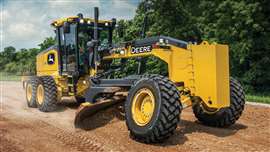Trendlines: Motor grader momentum
08 August 2023
 One of John Deere’s GP Series motor graders. The equipment type has experienced a decline in sales since the early 2010s. (Photo: John Deere)
One of John Deere’s GP Series motor graders. The equipment type has experienced a decline in sales since the early 2010s. (Photo: John Deere)
Annual sales of motor graders have been in a gentle but clear state of decline for several decades. Sales volumes were around the 4000 units per year mark in the 1990s and 2000s, and close to 5000 units in the mid-decade boom of the 2000s. But the trend has been downwards since the early 2010s, with each cyclical peak in sales being lower than the last. It is rare now for more than 3500 graders to be sold in a year in North America.
What’s more, the striking feature of the market over the last two years is that it has not bounced back. Sales dipped in 2020 as the pandemic struck, but while every other equipment type saw a rebound in 2021 and 2022, grader sales for the last two years have remained at a low level.
One of the difficulties in calling the motor grader market is that they are incredibly long-lived machines, so even with infrastructure work trending upwards, the increase in grader sales may be relatively modest given that there is a large population available in the marketplace. By the same token, there was a peak in grader sales in the early 2010s, and it may be that with a promising pipeline of work ahead, contractors and rental companies might take the opportunity to replace these aging machines.
Contributors to decline
More existentially, there is a question as to whether product improvements over the last two decades have contributed to the decline in sales. Machine control packages are now the norm when a new grader is sold because of the productivity benefits they bring. But if the fleet of graders is more productive than it was before, the market needs fewer of them to complete a given amount of work.
 Chris Sleight, managing director, Off-Highway Research.
Chris Sleight, managing director, Off-Highway Research.
Even with this technology, along with improvements in operator control systems, graders remain among the more challenging machine types to operate. Some therefore argue that a lack of skilled workers (whether or not you give credence to The Great Retirement argument) is having an effect. There’s no point in buying a machine if there’s no one able to operate it.
But we can’t discount market forces. The main driver for other equipment sales bouncing back in 2021 and 2022 was the boom in housebuilding. That shows up particularly in sales of compact excavators and compact track loaders.
But of course, residential building is not much of a driver for grader sales. Infrastructure is the most important component of construction for these machines. There are also higher value/lower volume sales to be had for the large grader classes in mining and quarrying, but the rise in commodity prices does not appear to have helped over the last two years.
Upturn ahead
With these drivers in place, one would expect to have seen an uptick in the market in the last two years, even if our “old friends” shipping bottlenecks and component shortages were playing their part.
But Off-Highway Research thinks an upturn is in the mail as infrastructure activity starts to pick up. Our forecast is for two to three years of improving sales.
However, we also acknowledge the long-term trend in the market and believe after the peak that is coming, the subsequent low might be painful for those in the market.




